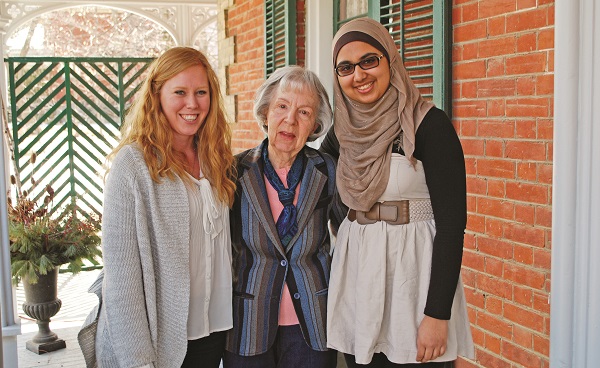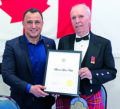General News » News
Oral history project unites generations and cultures
March 25, 2015 · 0 Comments

By Brock Weir
Elsie Adair first arrived in Aurora in 1958, ready to teach youngsters at the then-recently opened George Street Public School.
After a short while commuting back and forth between her home well outside Aurora and the school, she quickly decided to make Aurora her home, and it is a relationship which endures today.
When she was asked to share her memories on video for an oral history project spearheaded by the Aurora Historical Society, the Senior Wish Association, and students from Aurora High School, she wasn’t sure she fit the bill.
“They were looking for people who were born in Aurora and spent many years of their lives here,” says Ms. Adair on her thoughts after first being approached for the project by Erika Mazanik of the Aurora Historical Society. “I told Erika I didn’t come to Aurora until I was in my early 20s, but from then I have been faithful ever since! Erika, being the charming person she is, just talked me right into the interview that night and I didn’t even have my hair done!”
Interviewed by Ms. Mazanik, Ms. Adair (who when asked her age in the politest way possible responds “I have a theory – ladies don’t like to tell their age until they hit 80 and then they brag about it. I am not going to tell you which group I am in, but they’re close!”) recalls a time in the education system that might seem somewhat foreign to today’s youth.
Once she became involved in education in Aurora, it truly became Ms. Adair’s life, staying at the school until 1984 until illness forced her to bow out. Upon her arrival, she found the George Street staff were something of a cooperative, a particularly welcome environment for a novice teacher. Teachers were encouraged to try out different schools, but Elsie did her best to buck the trend, embracing the “loving, caring community” at the school – and trying to foster that sense within its walls.
To underscore this point, she recalls students coming into the school from a former area group home, and one girl in particular who was having particular trouble making that all-important transition.
“The students and staff all came together around her like that to make her feel so welcome, and gave us a year with [the kids] before they had to move on for some reason, and I think that made quite a difference in their lives,” she says.
These small snapshots of Aurora life in days gone by are particularly valuable to the Aurora Historical Society and over the past year they have made it their mission to preserve these first-hand recollections for future generations.
The Society’s program was financed largely by the Federal Government’s New Horizons for Seniors program for a six month period, which wrapped up February 28. Although the funding period is closed, the investment they made through that program has left behind an infrastructure of equipment that will allow the program to carry on.
“I learned a lot,” says Ms. Mazanik of interviewing participating seniors. “There were some common themes. Aurora has grown so much over the years and people still view it as a small town, and the small town that it was in the 50s and 60s. These [videos] are to be kept forever, so I hope people will be able to see what Aurora was like and the differences between then and now. The strong community sense that was here 100 years ago and 50 years ago is still here today, and hopefully it is still here in the future.”
One of these common themes was the area “east of Bayview.” In many of the recollections shared by participants of this program, Aurora as a community ended at that Bayview divide, well before it as a bustling, developing hub of Aurora.
This was particularly eye-opening for Heba Shahaed, a 15 year old student at Aurora High School, who moved to this “new” area of town with her family five years ago. After Erika made her pitch to high school students looking for keen, young interviewers, she says she struck gold with Heba.
“I came to Aurora five years ago and I felt like I didn’t know about where I was living,” she says. “I wanted to know more about how this place was before and different things about it – and I learned many different things.”
Heba was treated to stories of the Aurora Horse Show, families spending their summer evenings picnicking and fishing along the creeks and taking in festivals and parades. Some of these traditions, such as the Canada Day Parade, endure, stimulating a new interest in the student to take in these events for herself.
“Heba was a natural coming up with questions based on what people were talking about,” says Erika. “She hit on all those key points, which is the mark of a really good interview.”
Adds Heba: “I was so happy to be a part of this program and I hope it continues to grow because I feel it is very important to know what Aurora was, how we were a community, so that even in the future, people can see how much it has changed.”
To learn more about Aurora’s history through the people that lived it, visit www.letstalkaurora.ca.











